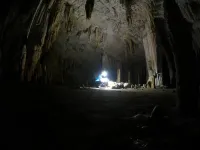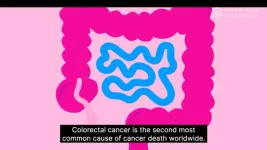From molecular rendezvous to brain disease: 1.5 million euros for Berlin researcher
European Research Council awards “Starting Grant” to Dr. Dragomir Milovanovic
2023-11-06
(Press-News.org) Dr. Dragomir Milovanovic, a neuroscientist at DZNE’s Berlin site, has been awarded an European Research Council (ERC) “Starting Grant” worth 1.5 million euros to investigate biophysical phenomena relevant to brain diseases in a groundbreaking research project. Ultimately, the goal is to better understand the behavior of aberrant protein inclusions in neurodegenerative diseases.
Human cells are complex entities comprising proteins, lipids and a wide number of other molecular spieces, some of them forming organized compartments, while others virtually float around. “The cell interior is by no means a homogeneous mass. It contains various constituents like the mitochondria, known as the powerhouses of the cell, or the nucleus that holds the genome,” says Milovanovic. “And there are other intricate structures that are essential for the cell’s proper functioning. All these so-called organelles are embedded in a fluid, the cytosol, which is a kind of cocktail of different ingredients.”
Microscopic droplets
Against this background, the Berlin scientist conceived the now funded research project “MemLessInterface”, with which he aims to elucidate how different constituents inside neurons interact. A question significant not only for regular operation, but also for pathological processes such as those that occur in neurodegeneration. Specifically, Milovanovic and his team will be studying the contact between membranes and so-called biomolecular condensates. “Some of the cell organelles are encased in a hull of fatty molecules, referred to as membrane. On the other hand, in the cytosol, we have biomolecular condensates that resemble tiny droplets suspended inside a larger liquid, and which have no such membranes,” he explains.
Close encounters
“Biomolecular condensate” is a generic term that describes fluid-like behavior rather than chemical composition. In fact, these condensates can comprise a wide variety of biopolymers: for example, assemblies of proteins, nuclein acids, or even more complex structures. Failure to regulate these condensates occurs in Alzheimer’s, Lewy Body dementia and other neurodegenerative disorders. As a consequence, abnormal proteins cluster together, contributing to cellular dysfunction and neuronal loss. However, biomolecular condensates also exist in healthy cells. “It is currently agreed that these condensates are involved in cellular functions like packaging of nucleic acids or for communication between neurons. To do so, they need to interact with other cell compartments, especially with organelles surrounded by membranes”, Milovanovic says. Yet, at present there is no understanding of what happens when organelles with membranes meet biomolecular condensates. “Do they stay together or do they separate again? And what does that depend on? This is where my project comes in. I would like to find out what is going on during these molecular rendezvous. I hypothesize that this first encounter is crucial and determines whether it develops into a harmonious or a pathological relationship,” he says. “I don’t mean that just as a metaphor, it is really about the roots of neurodegeneration.”
The outer rim
To get to the bottom of this, the Berlin researcher and his team will be applying cutting-edge scientific methods. As a paradigm, the focus will be on “synaptic vesicle condensates”. They are assemblies of small bubbles held together by proteins that act like a liquid glue. These condensates occur at the outer rim of neurons, in the so-called synapse, where neurons connect. “Synaptic vesicle condensates consist of a biomolecular condensate represented by the cross-linking proteins, and they also contain membranes. Namely, the membranes forming the bubbles. This setting provides the opportunity to study interactions between these different components,” Milovanovic explains. „This will give us insights into the contact between membrane-less and membrane-bound cellular components. That’s important for understanding the regular function of neurons and also crucial in the context of brain diseases associated with protein aggregation.”
--
About the Deutsches Zentrum für Neurodegenerative Erkrankungen, DZNE (German Center for Neurodegenerative Diseases): DZNE is a research institute funded by the German federal and state governments, comprising ten sites across Germany. It is dedicated to diseases of the brain and nervous system, such as Alzheimer’s, Parkinson’s, and ALS, which are associated with dementia, movement disorders and other serious health impairments. To date, there are no cures for these diseases, which represent an enormous burden for countless affected individuals, their families, and the healthcare system. The aim of DZNE is to develop novel strategies for prevention, diagnosis, care, as well as treatment, and to transfer them into practice. To this end, DZNE cooperates with universities, university hospitals, research centers and other institutions in Germany and abroad. The institute is a member of the Helmholtz Association and belongs to the German Centers for Health Research. www.dzne.de/en
END
ELSE PRESS RELEASES FROM THIS DATE:
2023-11-06
Over the past few decades, algae have been slowly edging corals out of their native reefs across the globe by blocking sunlight, wearing the corals down physically, and producing harmful chemicals. But in recent years, a new type of algal threat has surfaced in tropical regions like the Caribbean—one that spreads quickly and forms a crust on top of coral and sponges, suffocating the organisms underneath and preventing them from regrowing. In an article publishing in the journal Current Biology on November 6, a team of marine biologists report that peyssonnelioid alga crusts, or PACs, ...
2023-11-06
University of Oxford news release
Strict embargo until Monday, 6 November, 2023. 11.00 (ET) or 16.00 (GMT)
Domestic cats introduced from the Near East and wildcats native to Europe did not mix until the 1960s, despite being exposed to each other for 2,000 years, according to two research papers published today in Current Biology.
An international team has found new archaeological and genetic evidence which transforms our understanding of the history of cats in Europe. The team sequenced and analysed both wild and domestic cats, including ...
2023-11-06
This huge step forward in understanding how neurons communicate through extremely short proteins called neuropeptides will help scientists understand how our emotions and mental states are controlled, as well as widespread neuropsychiatric conditions like eating disorders, OCD and PSTD.
The map, which details 31,479 neuropeptide interactions between the worm’s 302 neurons, shows where each neuropeptide, as well as each receptor for those peptides, acts in the animal’s nervous system. Neuropeptides allow communication between neurons that are not immediately ...
2023-11-06
Reykjavik 6. November 2023.
Epidemiology and Genetics of Clonal Hematopoiesis, a Premalignant Hematopoietic Stem Cell Condition
A comprehensive new study from deCODE genetics, a subsidiary of Amgen, published today in Nature Genetics, provides insights into the epidemiology and somatic and germline genetics of clonal hematopoiesis. Whole genome sequence data from Iceland and the UK Biobank, combined with a unique somatic mutation Barcoding strategy, was used to investigate clonal hematopoiesis at the population scale.
Clonal hematopoiesis is a condition that arises when a single clonal lineage ...
2023-11-06
About The Study: In this study of 185 women with breast cancer, high neighborhood deprivation was associated with differences in tissue DNA methylation and gene expression among Black women. These findings suggest that continued investment in public health interventions and policy changes at the neighborhood level may help to remedy biological alterations that could make minoritized populations more susceptible to chronic diseases.
Authors: Stefan Ambs, Ph.D., of the National Cancer Institute in Bethesda, ...
2023-11-06
Irvine, Calif., Nov. 6, 2023 — Agriculture is one of the hardest human activities to decarbonize; people must eat, but the land-use practices associated with growing crops account for roughly a quarter of global greenhouse gas emissions. Researchers at the University of California, Irvine and other institutions evaluate a new solution to this problem, one that eliminates farms altogether.
In a study published today in Nature Sustainability, the UCI-led team of scientists assess the potential for widescale synthetic production of dietary fats through chemical and biological processes. The raw materials for this method are the same as those used by ...
2023-11-06
Keeping an eye on the regions when it comes to climate change
Up to now, the results of climate simulations have sometimes contradicted the analysis of climate traces from the past. A team led by the physicist Thomas Laepple from the Alfred Wegener Institute in Potsdam and the climatologist Kira Rehfeld from the University of Tübingen has therefore brought together experts in climate models and climate tracks to clarify how the discrepancies come about. The surprising result has now been published in the journal Nature Geoscience: in a way, both sides ...
2023-11-06
BOSTON – In June 2022, the U.S. Supreme Court overruled Roe v. Wade, effectively ending 50 years of federal protections to abortion care. As of October 2023, twenty-six states have since enacted laws to ban or restrict abortion access, with 14 states completely banning the procedure. Today, an estimated 25 million American women of childbearing age, or about one third of women ages 15 to 45, live in areas where abortion care is severely restricted. Historically, many states were able to restrict access to abortion even before 2022 through Targeted Regulation of Abortion Providers (TRAP) laws; these laws decrease ...
2023-11-06
Multiple sclerosis patients whose blood tests reveal elevated NfL, a biomarker of nerve damage, could see worsening disability one to two years later, according to a new study spearheaded by researchers at UC San Francisco.
The study is the first to quantify the timeframe preceding disability worsening in which injury to the central nervous system takes place, said co-first author Ahmed Abdelhak, MD, of the UCSF Department of Neurology and the Weill Institute for Neurosciences.
Almost 1 million Americans ...
2023-11-06
Article in Nature Communications demonstrates that with 96% sensitivity, AI diagnostic MSIntuit™ CRC can rule out almost half of the MSS population of colorectal cancer patients unlikely to respond to checkpoint inhibitor therapy from additional screening.
Such AI-enabled solutions have the potential to improve lab efficiency, addressing global pathology shortages and reducing testing burden to match the right patients to the right therapies.
Paris and New York., 6 Nov 2023 – In a peer-reviewed study published today in Nature Communications, a team of scientists ...
LAST 30 PRESS RELEASES:
[Press-News.org] From molecular rendezvous to brain disease: 1.5 million euros for Berlin researcher
European Research Council awards “Starting Grant” to Dr. Dragomir Milovanovic




